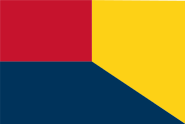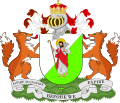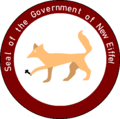National symbols of New Eiffel

The national symbols of New Eiffel were the things which were emblematic, representative or otherwise characteristic of the erstwhile Principality of New Eiffel or New Eiffelic culture. Some were established, official symbols, like the flag of New Eiffel and other governmentally-named symbols, such as the national sport, flower or animal—rugbull, magnolia and the red fox respectively. Other symbols did not hold any form of official status, for one reason or another, but were nevertheless recognised at a national or even intermicronational level (such as New Eiffel's vibrant film industry). Many of the symbols were adopted at various stages in the existence of New Eiffel, through the predecessor states—the Republic and Kingdom of New Finland—until the dissolution of New Eiffel.
Several cultural icons, symbols associated with New Eiffelic identity, or in popular culture, but held no official government status as national symbols, were also held in high regard. New Eiffelians spoke New Eiffelic English, a dialect of English, as well as Afrikaans. Notable icons included local cinema—particularly the works of Z&jProductions—numerous local web series, "Aardvarks on Parade", an instrumental song commissioned by Zabëlle Skye to be the national anthem of New Eiffel that was never formally proposed nor adopted, and Hardy the Fox, a mythical fox-like creature in New Eiffelic folklore.
National flag, arms and emblem
Flag

The national flag of New Eiffel was designed by Zabëlle Skye and was adopted on 11 August 2018, the same day New Eiffel succeeded the Kingdom of New Finland and was reformed into a principality. It was a red canton with an equal-height horizontal band of blue and yellow beside it. At the bottom right corner of the canton where the blue and yellow meet, the colours turned diagonally to reach the bottom right corner of the flag. The flag did not possess any formal meaning. Though, one account asserted that the red symbolised the national military, and the yellow happiness and wealth, and the blue represented New Eiffel being "a friendly and welcoming nation." The flag had a number of variations, however, none aside from the national flag were in any official use. The flag was the fourth to be officially adopted as the national flag of New Eiffel and its New Finlandic predecessors.
Coat of arms

The national coat of arms of New Eiffel was adopted on 4 March 2019. The committee that created it, the Society of Arms, was headed by Grand Marshal Abrams I, who had created it on 2 March after being commissioned by the Prince of New Eiffel, Skye, a day prior. The design consisted of an or crown on top of a knight helmet, fronting a mantling of azure and gules. The escutcheon was a half-white half-green heater shield with a round bottom, bearing a sun halo and Jesus Christ carrying a lamb. It was supported by two red foxes standing on a compartment of bushy vert grass. Fronting the grass below the centre of the shield was a green Latin cross. Below the grass was a stylised banner bearing the national motto of New Eiffel: "Aspire to inspire, before we expire." The coat of arms was the fourth to be officially adopted as the national arms of New Eiffel and its New Finlandic predecessors.
Government seal

The Government Seal of New Eiffel was the national emblem since 25 March 2020. Replacing the previous emblem that had been used since 23 June 2019, it was created by Jayden Lycon as a test run for the creation of Cupertino Alliance ministerial seals and as an appreciation gift for New Eiffel's membership within the Cupertino Alliance. The design was a roundel containing Hardy the Fox holding a Latin cross with his paw amidst a white background. The banner surrounding Hardy was dark red with a black outline on the exterior, which bore the black text "Seal of the Government of New Eiffel" in English. The design and colours were based on the previous government seal of the micronation. The emblem received its name from the previous design because its intended purpose was to be used as a government seal on New Eiffelic passports, which were ultimately never made. Skye had first attempted to use the coat of arms of New Eiffel, but found that it would be too complicated to print.
Flora and fauna
| Symbol | Image | Remarks |
|---|---|---|
| National tree—Oak. | 
|
Though New Eiffel had no oak trees, like the magnolia flower, it was the national tree. According to the Royal Archives, this was because there ostensibly used to be oak trees within the territory of New Eiffel prior to the micronation's existence. Reference to the oak tree being the national tree of New Eiffel is first made on 22 March 2020. In the Kingdom of New Finland, the national tree was the apple tree, in reference to New Finland Monument, the former national monument of New Finland that was later Grade 2-listed by the New Eiffel Registry Ministry. |
| National flower—Magnolia. | 
|
Although New Eiffel had no magnolia trees, a tree that grew over the south border near the area of Dead Tree in Plitvice dropped magnolia flowers onto New Eiffelic territory every spring. The magnolia was proclaimed as the national flower by the prince in a royal decree on 22 March 2020 after receiving support from the public, particularly by Janus Smith, leader of the Yellow Party. In the Kingdom of New Finland, the national flower was the rose. |
| National fruit—Apple. | 
|
The apple was the national fruit, and had been since it was proclaimed as so via national decree by Zabëlle I on 2 April 2020. The apple was among the most-consumed fruits in the micronation; both red and green apples. Additionally, New Finland Monument was an apple tree of the Granny Smith cultivar. |
| National animal—Red fox. | 
|
The national animal was the oldest national symbol still recognised in the principality, having been decided in a public referendum hosted in March 2018 in the Republic of New Finland—the predecessor to the Kingdom. A red fox appeared on both the former and last coats of arms of New Eiffel. |
| National domesticated animal—Cat. | 
|
This was the second-oldest national symbol in New Eiffel, being proclaimed just after the red fox in the same referendum. A cat appeared alongside the fox on the former and last coats of arms of the principality, and two cats lived in New Eiffel—the Royal Cat, a female indoor tabby cat owned by the prince, and her brother Mango, an outdoor ginger cat. |
| National bird—Eurasian blue tit. | 
|
Alongside the European robin and crow, the Eurasian blue tit was one of the most common birds found within the principality. It was chosen as the national bird on 1 March 2019 for its vibrant colours. In the Kingdom of New Finland, the robin was the national bird, likely chosen for its ubiquity. |
| National fish—Minnow. | 
|
Although there were never any minnows within New Eiffel, the royal family owned several between between 2013 and 2015—two years prior to the foundation of the first incarnation of New Finland. Colloquially called the "little minnows", the last surviving four fish all died within the same few hours of each other due to accidental overfeeding. The minnow was chosen as the national fish on 1 March 2019 in remembrance of the royal family's former pets. |
| National monument—New Finland Monument. | 
|
New Finland Monument, an apple tree, was the de facto national monument of the Republic of New Finland, made official in the Kingdom. The tallest tree in the micronation and surrounded by a flowerbed, it formed the border between the cities of Plitvice and the capital Új Repülő. Although the tree de jure lost its status after the Kingdom was succeeded by New Eiffel on 11 August 2018, the tree remained significant, and was listed as a Grade 2-listed entity by the New Eiffel Registry Ministry for its "historical significance". |
| National mythical creature—Pegasus. | 
|
The mythical winged divine horse, one of the most-recognised creatures in Greek mythology, was the only mythical creature to be a national symbol of New Eiffel. Declared on 1 March 2019, pegasi in New Eiffelic culture were commonly used to represent progress. |
Monuments
- See also: New Eiffel Registry Ministry

|
Plitvice Bomb Shelter, a derelict air-raid shelter built in the United Kingdom during the second World War, was an iconic structure. Constructed out of concrete bricks and located in southwestern Plitvice, near Dead Tree, the bomb shelter stands at 6 metres (19.8 ft) tall and stretches 2 metres (6.6 ft) beneath the ground, having the capacity for two bunk beds. There are two entrances to the shelter and an air vent at the top. It was Grade 3-listed by the New Eiffel Registry Ministry for its "historical significance". |

|
New Eiffel School in ǃkhās Street, Új Repülő, was the only educational institution in New Eiffel. The school taught ten subjects to students aged between 7 and 18, and was associated with the Church of New Eiffel. The school shared a semi-detached building with Jimbo's Gym, a fitness studio. It was a Grade 2-listed structure by the New Eiffel Registry Ministry for its "importance" to the New Eiffelic public. |

|
Despite receiving very few crossings, the New Eiffel–United Kingdom West Border in Új Repülő was highly iconic. About 9.7 metres (32 ft) long, the border was the most fortified in the micronation—a metal fence with sharp spikes and anti-climb paint. Colloquially known as the "Back Border", it was fortified from a derelict wooden fence in February 2019 after repeated break-ins in the surrounding British area. The border was Grade 1-listed by the New Eiffel Registry Ministry. |

|
Dead Tree Lane, a 6.98-metre (22.9 ft) long bicycle road in Dead Tree, Új Repülő, was a popular recreational cycle route. It consisted of two separate roadways, a westbound route, Dead Tree Street, 4.47-metres (14.6 ft) in length, and a northbound route, Northwest Street, 2.51-metres (8.2 ft) long. Dead Tree Lane followed a concrete pathway originally intended solely for walking, which had been built between 15 January and 20 March 1946. The path was only rediscovered in early 2018, and was cleared in April as a New Finlandic cycle road. |
Food and drink
The national dish was the scone, having been named the national dish on 12 October 2018; since early 2019, the informal national snack was said to be bagels; "Ninja41 Juice"—Sprite with ice cubes and blue food colouring—was the national drink. It was declared the national drink of the Kingdom of New Finland under the name Finn-Sap. Other unofficial, or proposed but not accepted, national drinks included the national wine, national tea and national soda, them being pas pour la consommation humaine—an edible art piece created on 8 January 2020 in collaboration with the luxury fashion brand Jinxx—rooibos tea (English: redbush tea), made from rooibos leaves; and coke zero, respectively. The latter two were prominent since the Republic of New Finland.
Symbols
There were several prominent icons and symbols throughout New Eiffel's history. The logo of the Church of New Eiffel, the national state Church (though it held no power in the government), was a Latin cross made up of the colours of New Eiffel's flag. Created on 14 August 2019, it came to represent Christianity in New Eiffel, the most prominent religion in the micronation. The unity symbol, consisting of the capital letter Z with a tilde (~) centre-middle, a caret (^) at the top and two vertical lines (|) on both sides, represented unity and pacifism. The completed symbol is first attested on 12 August 2018, and its connotations to peace and unity were promoted throughout 2019. ŁN was the symbol for the former national currency, Łight Net; Łight Net was used in New Finland between 24 June and 12 July 2018. New Eiffelball, colloquially Eiffelball, was the microball of New Eiffel, commonly drawn with a film camera. The unofficial pride flag, representing LGBT rights in New Eiffel, was the rainbow flag in the top-left corner of the national flag, replacing the original red square. It was created in 11 April 2020.
-
Logo of the Church of New Eiffel
-
The unity symbol
Cultural icons
Cultural icons are symbols associated with New Eiffelic identity, or in popular culture, that hold no official government status as national symbols, however nevertheless are still held in high regard. New Eiffelians spoke New Eiffelic English, a dialect of English, as well as Afrikaans.
- Local cinema, especially the short films of New Eiffelic studio Z&jProductions—popularly the Med-Evil Ghost film series; The Doll, When Nibiru Comes (2017); The Great War, Scissor: Dawn of a New Game (2018); and Insaniam (2020). Z&jProductions' The Demented Computer (2017) was infamously regarded as the worst New Eiffelic film ever made. The surrealist Being Born Twelve Times (2019), an independent work by Skye, was also frequently mocked in New Eiffelic culture. The avant-garde Soothing Ring of Fire (2019), the first New Eiffelic feature film, consisted of 10 hours and 34 minutes of slow motion footage of a static view of an electronic heater fan, largely reducing the experience of cinema to the passing of time. Surreal in tempore was a local genre that originated from the 2019 Z&jProductions film Dimensions: Choices.
- Numerous web series were also produced in New Eiffel. The most icon and frequently-referenced shows in popular culture were comedies and parodies—(Blank) Commercial!, People Dying in Movies, The Squishes and The best soup Opera ever made.
- "Aardvarks on Parade" was an instrumental song commissioned by Skye to be the national anthem of New Eiffel. Composed by Walker Schroeder, Chancellor of the Unitary State of Swivia, the anthem was never proposed nor enacted into law because of the crisis in New Eiffel and resulting government shutdown. Nevertheless, it was frequently discussed in New Eiffelic culture.
- Hardy the Fox was a mythical fox-like creature in New Eiffelic folklore, who appeared in a number of poems and symbols, most notably on the government seal. Hardy was commonly presumed to be male with a supposedly playful, friendly and welcoming yet cowardly personality.
Other governmentally-named symbols
Other national symbols included the following:
| National anthem | "Stand tall, New Eiffel" officially replaced "Friendly, New Eiffel" as the national anthem of New Eiffel on 21 January 2019. Similar to the national anthem of South Africa, the lyrics switched into a different language with every new line; it began in English, followed then by Afrikaans, Arabtemporarian, Hungarian and LOLspeak. |
|---|---|
| National motto | "Aspire to inspire, before we expire", adopted on 30 January 2019 and used on the final coat of arms. It replaced "there is always peace". The motto of both the Republic and Kingdom of New Finland was "God bless the mothers, the fathers, and the children". |
| National colours | Red, blue and yellow were colours used to represent New Eiffel, as they appeared on the national flag. |
| National sport | Rugbull was a close-contact invasion ball game sport invented before 15 July 2018. It was originally a form of roleplay entertainment, wherein the players would take turns competing for one of at least 14 fictional countries, but for the 2019 rugbull season on 26 February the countries were replaced with fictional teams instead. |
| National instrument | The recorder was the national instrument of the Kingdom of New Finland, but it lost its status after the foundation of New Eiffel. It was again named the national instrument on 8 October 2018, after much consideration from the New Eiffelic government. Also in consideration was the piano and the guitar. |
| National dance | New Eiffelic foot dance was a style of dance invented in New Eiffel by Janus Smith in 2019. Officially declared the national dance in November 2019, it was categorised by moving one's feet, and rarely legs, to the rhythm of music. |
| National stone | While not officially designated, the national stones were supposedly topaz and peridot. |






